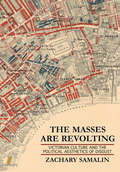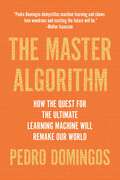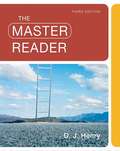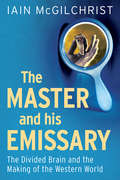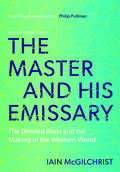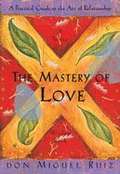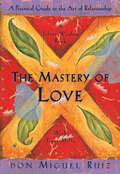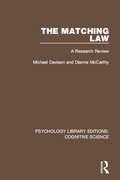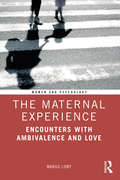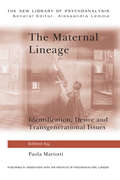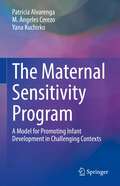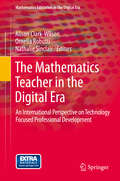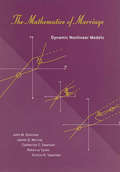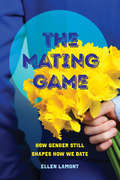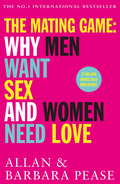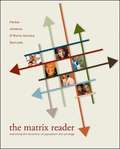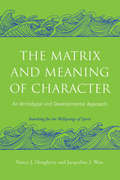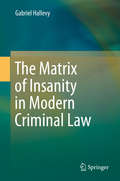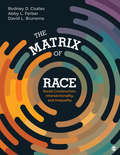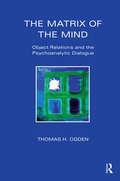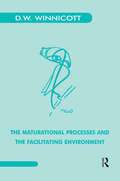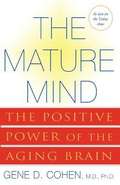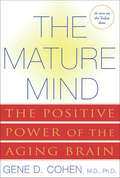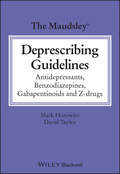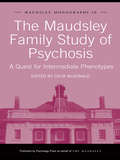- Table View
- List View
The Masses Are Revolting: Victorian Culture and the Political Aesthetics of Disgust
by Zachary SamalinThe Masses Are Revolting reconstructs a pivotal era in the history of affect and emotion, delving into an archive of nineteenth-century disgust to show how this negative emotional response came to play an outsized, volatile part in the emergence of modern British society. Attending to the emotion's socially productive role, Zachary Samalin highlights concrete scenes of Victorian disgust, from sewer tunnels and courtrooms to operating tables and alleyways. Samalin focuses on a diverse set of nineteenth-century writers and thinkers—including Charles Darwin, Charles Dickens, Karl Marx, Friedrich Engels, Thomas Hardy, George Gissing, and Charlotte Brontë—whose works reflect on the shifting, unstable meaning of disgust across the period.Samalin elaborates this cultural history of Victorian disgust in specific domains of British society, ranging from the construction of London's sewer system, the birth of modern obscenity law, and the development of the conventions of literary realism to the emergence of urban sociology, the rise of new scientific theories of instinct, and the techniques of colonial administration developed during the Indian Rebellion of 1857. By bringing to light disgust's role as a public passion, The Masses Are Revolting reveals significant new connections among these apparently disconnected forms of social control, knowledge production, and infrastructural development.
The Master Algorithm: How the Quest for the Ultimate Learning Machine Will Remake Our World
by Pedro DomingosAlgorithms increasingly run our lives. They find books, movies, jobs, and dates for us, manage our investments, and discover new drugs. More and more, these algorithms work by learning from the trails of data we leave in our newly digital world. Like curious children, they observe us, imitate, and experiment. And in the world’s top research labs and universities, the race is on to invent the ultimate learning algorithm: one capable of discovering any knowledge from data, and doing anything we want, before we even ask. Machine learning is the automation of discovery--the scientific method on steroids--that enables intelligent robots and computers to program themselves. No field of science today is more important yet more shrouded in mystery. Pedro Domingos, one of the field’s leading lights, lifts the veil for the first time to give us a peek inside the learning machines that power Google, Amazon, and your smartphone. He charts a course through machine learning’s five major schools of thought, showing how they turn ideas from neuroscience, evolution, psychology, physics, and statistics into algorithms ready to serve you. Step by step, he assembles a blueprint for the future universal learner--the Master Algorithm--and discusses what it means for you, and for the future of business, science, and society. If data-ism is today’s rising philosophy, this book will be its bible. The quest for universal learning is one of the most significant, fascinating, and revolutionary intellectual developments of all time. A groundbreaking book, The Master Algorithm is the essential guide for anyone and everyone wanting to understand not just how the revolution will happen, but how to be at its forefront.
The Master Reader (3rd Edition)
by D. J. HenryDJ Henry's reading series is form integrated with function at its best! Throughout each text, Henry combines solid skill instruction with a wealth of guided practice and a reading process (SQ3R) to develop abilities students need to become master readers and critical thinkers.
The Master and His Emissary
by Iain McgilchristWhy is the brain divided? The difference between right and left hemispheres has been puzzled over for centuries. In a book of unprecedented scope, Iain McGilchrist draws on a vast body of recent brain research, illustrated with case histories, to reveal that the difference is profound--not just this or that function, but two whole, coherent, but incompatible ways of experiencing the world. The left hemisphere is detail oriented, prefers mechanisms to living things, and is inclined to self-interest, where the right hemisphere has greater breadth, flexibility, and generosity. This division helps explain the origins of music and language, and casts new light on the history of philosophy, as well as on some mental illnesses.In the second part of the book, McGilchrist takes the reader on a journey through the history of Western culture, illustrating the tension between these two worlds as revealed in the thought and belief of thinkers and artists, from Aeschylus to Magritte. He argues that, despite its inferior grasp of reality, the left hemisphere is increasingly taking precedence in the modern world, with potentially disastrous consequences. This is truly a tour de force that should excite interest in a wide readership.
The Master and His Emissary: The Divided Brain and the Making of the Western World
by Iain McGilchristA new edition of the bestselling classic – published with a special introduction to mark its 10th anniversary This pioneering account sets out to understand the structure of the human brain – the place where mind meets matter. Until recently, the left hemisphere of our brain has been seen as the ‘rational’ side, the superior partner to the right. But is this distinction true? Drawing on a vast body of experimental research, Iain McGilchrist argues while our left brain makes for a wonderful servant, it is a very poor master. As he shows, it is the right side which is the more reliable and insightful. Without it, our world would be mechanistic – stripped of depth, colour and value.
The Mastery Of Love: A Practical Guide to the Art of Relationship (A Toltec Wisdom Book)
by Don Miguel Ruiz Janet MillsIn The Mastery of Love, don Miguel Ruiz illuminates the fear-based beliefs and assumptions that undermine love and lead to suffering and drama in our relationships. Using insightful stories to bring his message to life, Ruiz shows us how to heal our emotional wounds, recover the freedom and joy that are our birthright, and restore the spirit of playfulness that is vital to loving relationships. The Mastery of Love includes: <P><P> - Why "domestication" and the "image of perfection" lead to self-rejection - The war of control that slowly destroys most relationships - Why we hunt for love in others, and how to capture the love inside us - How to finally accept and forgive ourselves and others <P><P> "Happiness can only come from inside of you and is the result of your love. When you are aware that no one else can make you happy, and that happiness is the result of your love, this becomes the greatest mastery of the Toltec: the Mastery of Love." -- don Miguel Ruiz
The Mastery of Love: A Practical Guide to the Art of Relationship (A Toltec Wisdom Book)
by Don Miguel Ruiz Janet MillsIn The Mastery of Love, don Miguel Ruiz illuminates the fear-based beliefs and assumptions that undermine love and lead to suffering and drama in our relationships. Using insightful stories to bring his message to life, Ruiz shows us how to heal our emotional wounds, recover the freedom and joy that are our birthright, and restore the spirit of playfulness that is vital to loving relationships. The Mastery of Love includes: • Why "domestication" and the "image of perfection" lead to self-rejection • The war of control that slowly destroys most relationships • Why we hunt for love in others, and how to capture the love inside us • How to finally accept and forgive ourselves and others"Happiness can only come from inside of you and is the result of your love. When you are aware that no one else can make you happy, and that happiness is the result of your love, this becomes the greatest mastery of the Toltec: the Mastery of Love." — don Miguel Ruiz
The Matching Law: A Research Review (Psychology Library Editions: Cognitive Science)
by Michael Davison Dianne McCarthyOriginally published in 1988, the purpose of this title was to present a coherent summary of the previous 30 years’ of research on the way in which animals and humans distribute their behaviour between alternative sources of reinforcement. There were three reasons why the book was needed at the time. First, it makes use of the empirical results available, something only partially present in many theories of the time. Second, as a general source of information to gain understanding of the scope of research on behaviour allocation. Third, a text was needed that described the techniques of experimental design and data analysis in this area.
The Maternal Experience: Encounters with Ambivalence and Love (Women and Psychology)
by Margo LowyThe Maternal Experience explores the powerful and dynamic nature of maternal ambivalence and disrupts the conventional narrative of the mother’s lived experience by arguing that encounters with feelings of hatred are both universal and have the capacity to stimulate and enrich her maternal love. The book draws on the author’s personal mothering experiences, those of other women, and examples from film to inspire new introspection about the everyday maternal experience. Lowy takes a psychosocial approach to weave thinking from selected psychoanalytic and contemporary accounts together with personal stories to explore how maternal ambivalence operates, and how mothering is sourced in psychic struggles between loving and hating feelings in an atmosphere that is rife with social and personal expectations and prohibitions. By reworking the experience of maternal ambivalence, the book secures an understanding of the mother’s feelings of hatred as a catalyst for her love and allows these maligned and taboo emotions to be named and reframed into acceptable and transformative feelings. Brought alive by examples from film and first-hand experience, this book is fascinating reading for academics and students of psychology, maternal and women’s studies, and sociology, as well as practitioners in the fields of psychology, social work, medicine and counselling.
The Maternal Lineage: Identification, Desire and Transgenerational Issues (The New Library of Psychoanalysis)
by Paola MariottiWhy do women want to have children? How does one ‘learn’ to be a mother? Does having babies have anything to do with sex? At a time when mothers are bombarded by prescriptive and contradicting advice on how to behave with their children, The Maternal Lineage highlights various psychological aspects of the mothering experience. International contributors provide clinical examples of frequent and challenging situations that have received scarce attention in psychoanalysis, such as issues of neglect and psychical abuse. The transgenerational repetition from mother to daughter of distressing mothering patterns is evident throughout the book, and may seem inevitable. However, clinical examples and theoretical research indicate that, when the support of partner and friends is not enough, the cycle can be brought to an end if the mother receives psychoanalytic-informed professional help. The Maternal Lineage is divided into four parts: An Introduction including a review of the literature focusing on the mother-daughter relationship Pregnancy and very early issues Subfertility and its effects on a woman’s psyche The psychological aspects of major mothering problems: miscarriages, post-natal depression, adolescent motherhood. This timely book will be of value to psychoanalysts, psychotherapists and health professionals – obstetricians, psychiatrists, midwives and social workers.
The Maternal Sensitivity Program: A Model for Promoting Infant Development in Challenging Contexts
by Patrícia Alvarenga M. Ángeles Cerezo Yana KuchirkoThis book presents the Maternal Sensitivity Program (MSP), an eight-session home-delivered intervention designed to enhance overall maternal sensitivity to infant behavior between the third and the tenth month of life using video feedback and live modeling strategies. The intervention was based on successful international programs but was specifically developed to fit the realities and needs of low-income countries, whose public health services rely on scarce human and economic resources. The program aims to promote maternal acknowledgment of infant mental activity and model responses that encourage infants' communication of intentions, needs, desires, and emotions.The first part of the book provides an overview of core theories related to the concept of maternal sensitivity, illustrating how it varies across cultural contexts, and how it is shaped by economic scarcity. The second part of the book presents evidence of the effectiveness of sensitivity-based interventions, describes and provides a rationale for the Maternal Sensitivity Program (MSP), and proposes a framework for training interventionists seeking to implement the program in different contexts. The third part of the book presents the intervention manual, describing in detail the procedures in each of the eight sessions of the program. The Maternal Sensitivity Program: A Model for Promoting Infant Development in Challenging Contexts will be an invaluable resource for developmental psychologists, health care providers, and social workers who work with families in low-income countries and in contexts of social vulnerability and need to implement low-cost interventions to foster healthy child development.
The Mathematics Teacher in the Digital Era: An International Perspective on Technology Focused Professional Development (Mathematics Education in the Digital Era #2)
by Nathalie Sinclair Alison Clark-Wilson Ornella RobuttiThis volume addresses the key issue of the initial education and lifelong professional learning of teachers of mathematics to enable them to realize the affordances of educational technology for mathematics. With invited contributions from leading scholars in the field, this volume contains a blend of research articles and descriptive texts.In the opening chapter John Mason invites the reader to engage in a number of mathematics tasks that highlight important features of technology-mediated mathematical activity. This is followed by three main sections:An overview of current practices in teachers’ use of digital technologies in the classroom and explorations of the possibilities for developing more effective practices drawing on a range of research perspectives (including grounded theory, enactivism and Valsiner’s zone theory).A set of chapters that share many common constructs (such as instrumental orchestration, instrumental distance and double instrumental genesis) and research settings that have emerged from the French research community, but have also been taken up by other colleagues.Meta-level considerations of research in the domain by contrasting different approaches and proposing connecting or uniting elements
The Mathematics of Marriage: Dynamic Nonlinear Models
by John M. Gottman James D. Murray Catherine C. Swanson Rebecca Tyson Kristin R. SwansonDivorce rates are at an all-time high. But without a theoretical understanding of the processes related to marital stability and dissolution, it is difficult to design and evaluate new marriage interventions. The Mathematics of Marriage provides the foundation for a scientific theory of marital relations. The book does not rely on metaphors, but develops and applies a mathematical model using difference equations. The work is the fulfillment of the goal to build a mathematical framework for the general system theory of families first suggested by Ludwig Von Bertalanffy in the 1960s. The book also presents a complete introduction to the mathematics involved in theory building and testing, and details the development of experiments and models. In one "marriage experiment," for example, the authors explored the effects of lowering or raising a couple's heart rates. Armed with their mathematical model, they were able to do real experiments to determine which processes were affected by their interventions. Applying ideas such as phase space, null clines, influence functions, inertia, and uninfluenced and influenced stable steady states (attractors), the authors show how other researchers can use the methods to weigh their own data with positive and negative weights. While the focus is on modeling marriage, the techniques can be applied to other types of psychological phenomena as well.
The Mating Game: How Gender Still Shapes How We Date
by Ellen LamontDespite enormous changes in patterns of dating and courtship in twenty-first-century America, contemporary understandings of romance and intimacy remain firmly rooted in age-old assumptions of gender difference. These tenacious beliefs now vie with cultural messages of gender equality that stress independence, self-development, and egalitarian practices in public and private life.Through interviews with heterosexual and LGBTQ individuals, Ellen Lamont’s The Mating Game explores how people with diverse sexualities and gender identities date, form romantic relationships, and make decisions about future commitments as they negotiate uncertain terrain fraught with competing messages about gender, sexuality, and intimacy.
The Mating Game: Why Men Want Sex & Women Need Love
by Barbara Pease Allan PeaseInternational bestselling authors Allan and Barbara Pease (WHY MEN DON'T LISTEN AND WOMEN CAN'T READ MAPS) focus their insight and wit on the most popular, and some would maintain, important part of any relationship: sex. In their inimitable style they explore what men and women want from a sexual relationship and give humourous and practical advice. Discover:What men and women really want from love and sexHow to find a great partnerWhat to do when the chemistry is wrongHow to have a happy future with your partner
The Matrix Reader: Examining the Dynamics of Oppression and Privilege
by Abby L. Ferber Christina M. Jimenez Andrea O'Reilly Herrera Dena R. SamuelsWritten by four authors from different disciplinary backgrounds, this reader promotes a commitment to an intersectional approach to teaching race, class, gender and sexuality. Unlike most books of its kind, it highlights the duality of privilege and oppression and the effects that race, gender, and sexuality have on our lives. This reader includes poems, reflective literary prose, historical events and documents, images drawn from the media, contemporary statistics of inequalities, visual images, and tools that empower students to become agents for social change.
The Matrix and Meaning of Character: An Archetypal and Developmental Approach
by Nancy J. Dougherty Jacqueline J. WestCharacter structures underlie everyone’s personality. When rigidly defended, they limit us; yet as they become more flexible, they can reveal sources of animation, renewal and authenticity. The Matrix and Meaning of Character guides the reader into an awareness of the archetypal depths that underlie character structures, presenting an original developmental model in which current analytic theories are synthesised. The authors examine nine character structures, animating them with fairy tales, mythic images and case material, creating a bridge between the traditional language of psychopathology and the universal realm of image and symbol. This book will appeal to all analytical psychologists, psychoanalysts and psychotherapists who want to strengthen their clinical expertise. It will help clinicians to extend their clinical insights beyond a strictly behavioural, medical or cognitive approach, revealing the potential of the human spirit.
The Matrix of Insanity in Modern Criminal Law
by Gabriel HallevyThis book challenges the assumptions of modern criminal law that insanity is a natural, legally and medically defined phenomenon (covering a range of medical disorders). By doing so, it paves the way for a new perspective on insanity and can serve as the basis for a new approach to insanity in modern criminal law. The book covers the following aspects: the structure of the principle of fault in modern criminal law, the development of the insanity defense in criminal law, tangential in personam defenses in criminal law and their implications for insanity and the legal mechanism of reproduction of fault. The focus is on the Anglo-American and European-Continental legal systems. Given the attention consistently drawn by international and domestic events in this context, the book will be of interest to a broad and growing international audience.
The Matrix of Race: Social Construction, Intersectionality, And Difference
by Abby L. Ferber David L. Brunsma Rodney D. CoatesThe Matrix of Race, for race and ethnic relations courses, is written by three leading scholars -- Rodney D. Coates, David L. Brunsma, and Abby L. Ferber -- and reflects a very contemporary way of looking at race, minorities, and intergroup relations. Older texts use a "categorical" approach and feature a series of chapters that examine one minority group at a time (African Americans, Latino/a Americans, Asian Americans, Native Americans, etc.). Newer texts designed within the last 5-10 years are more likely to be organized topically, discuss various racial and ethnic minorities within the context of these topics, and use the most current theories and perspectives in this field. The Matrix of Race is built around these core ideas: -Race is a both a social construction and a social institution -Race is intersectional--it is embedded within other statuses (such as gender, social class, sexuality) -Concepts of race change over time and as we move from one physical location to another -We are all active agents in upholding, reproducing, or resisting constructions of race.
The Matrix of the Mind: Object Relations and the Psychoanalytic Dialogue
by Thomas OgdenThis book contributes to the retrieval of the alienated through the author's own acts of interpretation of ideas introduced by Melanie Klein, Donald Winnicott, Ronald Fairbairn, and Wilfred Bion. It is offered as an act of interpretation.
The Maturational Processes and the Facilitating Environment: Studies in the Theory of Emotional Development
by Donald W. WinnicottDonald Winnicott (1896-1971) was trained in paediatrics, a profession that he practised to the end of his life, in particular at the Paddington Green Children’s Hospital. He began analysis with James Strachey in 1923, became a member of the British Psychoanalytical Society in 1935, and twice served as its President. He was also a fellow of the Royal College of Physicians and of the British Psychological Society. The collection of papers that forms The Maturational Processes and the Facilitating Environment brings together Dr Winnicott’s published and unpublished papers on psychoanalysis and child development during the period 1957-1963. It has, as its main theme, the carrying back of the application of Freud’s theories to infancy. Freud showed that psycho-neurosis has its point of origin in the interpersonal relationships of the first maturity, belonging to the toddler age. Dr Winnicott explores the idea that mental hospital disorders relate to failures of development in infancy. Without denying the importance of inheritance, he has developed the theory that schizophrenic illness shows up as the negative of processes that can be traced in detail as the positive processes of maturation in infancy and early childhood.
The Mature Mind: The Positive Power of the Aging Brain
by Gene D. CohenPsychological aspects of the aging brain
The Mature Mind: The Positive Power of the Aging Brain
by Gene D. CohenThe Mature Mind delivers good news for those in the second half of life, with an extraordinary account of cutting-edge neuroscience, groundbreaking psychology, fascinating vignettes from history and case studies, and practical advice for personal growth strategies. Gene Cohen, a renowned psychiatrist and gerontologist, draws from more than thirty years of research to show that surprising positive changes in our brains have the powerful potential to enhance, not diminish, our lives after fifty.
The Maudsley Deprescribing Guidelines: Antidepressants, Benzodiazepines, Gabapentinoids and Z-drugs (The Maudsley Prescribing Guidelines Series)
by David M. Taylor Mark HorowitzThe Maudsley® Deprescribing Guidelines Comprehensive resource describing guidelines for safely reducing or stopping (deprescribing) antidepressants, benzodiazepines, gabapentinoids and z-drugs for patients, including step-by-step guidance for all commonly used medications, covering common pitfalls, troubleshooting, supportive strategies, and more. Most formal guidance on psychiatric medication relates to starting or switching medications with minimal guidance on deprescribing medication. In 2023, the World Health Organisation and the United Nations called for patients, as a human right, to be informed of their right to discontinue treatment and to receive support to do so. The Maudsley Deprescribing Guidelines fills a significant gap in guidance for clinicians by providing comprehensive and authoritative information on this important aspect of treatment. This evidence-based handbook provides an overview of principles to be used in deprescribing. This is derived from fundamental scientific principles and the latest research on this topic, combined with emerging insights from clinical practice (including from patient experts). Building on the recognised brand of The Maudsley Prescribing Guidelines, and the prominence of the authors’ work, including in The Lancet Psychiatry on tapering antidepressants (the most read article across all Lancet titles when it was released). The Maudsley Deprescribing Guidelines covers topics such as: Why and when to deprescribe antidepressants, benzodiazepines, gabapentinoids and z-drugs Barriers and enablers to deprescribing including physical dependence, social circumstances, and knowledge about the discontinuation process Distinguishing withdrawal symptoms, such as poor mood, anxiety, insomnia, and a variety of physical symptoms from symptoms of the underlying disorder that medication was intended to treat The difference between physical dependence and addiction/substance use disorder Explanation of why and how to implement hyperbolic tapering in clinical practice Specific guidance on formulations of medication and techniques for making gradual reductions, including using liquid forms of medication, and other approaches Step-by-step guidance for safely stopping all commonly used antidepressants, benzodiazepines, gabapentinoids and z-drugs, including fast, moderate and slow tapering regimens or schedules for each drug, and guidance on how to tailor these to an individual Troubleshooting issues which can arise on stopping these medications, including akathisia, withdrawal symptoms, acute or protracted, and relapse. Written for anyone interested in safe deprescribing of psychiatric medications including psychiatrists, GPs, pharmacists, nurses, medical trainees, and interested members of the public. The Maudsley Deprescribing Guidelines is an essential resource on the subject that provides practical guidance on how to improve patient outcomes in this field of medicine.
The Maudsley Family Study of Psychosis: A Quest for Intermediate Phenotypes (Maudsley Series #53)
by Colm McDonaldPsychotic disorders such as schizophrenia and bipolar disorder are known to be highly heritable. Despite decades of research, however, the genetic variations conferring susceptibility to these illnesses have yet to be identified. Such genetic variations most likely produce abnormalities of brain structure and function from which the clinical features of psychosis emerge. The Maudsley Family Study of Psychosis investigates the genetically produced markers of abnormal brain structure and function (‘intermediate phenotypes’) which underlie the clinical syndrome of schizophrenia, and more recently bipolar disorder. In this book, key findings of this important research program, and their implications for this field, are discussed in detail. Contributors outline research examining brain structure and functioning in patients with schizophrenia and their unaffected first degree relatives, incorporating detailed clinical assessments, magnetic resonance imaging, electrophysiology, eye tracking measures and neuropsychology. This book provides an improved understanding of illness pathways and potential scope for intervention in order to better manage and prevent psychotic disorders and will be of interest to academics and clinicians in the field.
